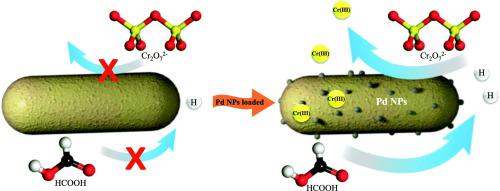Science of the Total Environment ( IF 9.8 ) Pub Date : 2021-09-15 , DOI: 10.1016/j.scitotenv.2021.150336 Yunfei Zhang 1 , Qiang Zhao 1 , Baoliang Chen 1

|
In materials science, “green” synthesis has gotten a lot of interest as a reliable, long-lasting, and ecofriendly way to make a variety of materials/nanomaterials, including metal/metal oxide nanomaterials. To accommodate various biological materials, green synthesis of metallic nanoparticles has been used (e.g., bacteria, fungi, algae, and plant extracts). In this work, Shewanella oneidensis MR-1 was used to biosynthesize palladium nanoparticles (bio Pd) under aerobic conditions for the Cr(VI) bio-reduction. The size and distribution of bio-Pd are controlled by adjusting the ratio of microbial biomass and palladium precursors. The high cell: Pd ratio has the smallest average particle size of 6.33 ± 1.69 nm. And it has the lowest electrocatalytic potential (−0.132 V) for the oxidation of formic acid, which is 0.158 V lower than commercial Pd/C (5%). Our results revealed that the small size and uniformly distributed extracellular bio-Pd could achieve completely catalytic reduction of 200 mg/L Cr(VI) solution within 10 min, while the commercial Pd/C (5%) need at least 45 min. The bio-Pd materials maintain a high reduction during five cycles. Microorganisms play an important role in the whole process, which can fully disperse palladium nanoparticles, completely reduce Cr(VI), and effectively adsorb Cr(III). This work expands our understanding and provides a reference for the design and development of efficient and green bio-Pd catalysts for environmental pollution control under simple and mild conditions.
Pd) under aerobic conditions for the Cr(VI) bio-reduction. The size and distribution of bio-Pd are controlled by adjusting the ratio of microbial biomass and palladium precursors. The high cell: Pd ratio has the smallest average particle size of 6.33 ± 1.69 nm. And it has the lowest electrocatalytic potential (−0.132 V) for the oxidation of formic acid, which is 0.158 V lower than commercial Pd/C (5%). Our results revealed that the small size and uniformly distributed extracellular bio-Pd could achieve completely catalytic reduction of 200 mg/L Cr(VI) solution within 10 min, while the commercial Pd/C (5%) need at least 45 min. The bio-Pd materials maintain a high reduction during five cycles. Microorganisms play an important role in the whole process, which can fully disperse palladium nanoparticles, completely reduce Cr(VI), and effectively adsorb Cr(III). This work expands our understanding and provides a reference for the design and development of efficient and green bio-Pd catalysts for environmental pollution control under simple and mild conditions.
中文翻译:

使用负载 Shewanella oneidensis MR-1 的生物合成钯纳米粒子还原和去除水中的 Cr(VI)
在材料科学中,“绿色”合成作为一种可靠、持久且环保的方法来制造各种材料/纳米材料,包括金属/金属氧化物纳米材料,已经引起了广泛的关注。为了适应各种生物材料,已使用金属纳米颗粒的绿色合成(例如细菌、真菌、藻类和植物提取物)。在这项工作中,Shewanella oneidensis MR-1 被用于生物合成钯纳米粒子(生物 Pd) 在有氧条件下用于 Cr(VI) 生物还原。bio-Pd 的大小和分布是通过调节微生物生物量和钯前体的比例来控制的。高电池:Pd 比率的最小平均粒径为 6.33 ± 1.69 nm。并且它具有最低的甲酸氧化电催化电位(-0.132 V),比商业Pd/C(5%)低0.158 V。我们的结果表明,体积小且分布均匀的细胞外生物钯可以在 10 分钟内完全催化还原 200 毫克/升 Cr(VI) 溶液,而商业 Pd/C (5%) 需要至少 45 分钟。生物钯材料在五个循环中保持高还原性。微生物在整个过程中发挥着重要作用,可以充分分散钯纳米粒子,完全还原Cr(VI),并有效吸附Cr(III)。这项工作扩展了我们的认识,并为设计和开发高效、绿色的生物钯催化剂在简单温和的条件下控制环境污染提供了参考。
Pd) 在有氧条件下用于 Cr(VI) 生物还原。bio-Pd 的大小和分布是通过调节微生物生物量和钯前体的比例来控制的。高电池:Pd 比率的最小平均粒径为 6.33 ± 1.69 nm。并且它具有最低的甲酸氧化电催化电位(-0.132 V),比商业Pd/C(5%)低0.158 V。我们的结果表明,体积小且分布均匀的细胞外生物钯可以在 10 分钟内完全催化还原 200 毫克/升 Cr(VI) 溶液,而商业 Pd/C (5%) 需要至少 45 分钟。生物钯材料在五个循环中保持高还原性。微生物在整个过程中发挥着重要作用,可以充分分散钯纳米粒子,完全还原Cr(VI),并有效吸附Cr(III)。这项工作扩展了我们的认识,并为设计和开发高效、绿色的生物钯催化剂在简单温和的条件下控制环境污染提供了参考。



























 京公网安备 11010802027423号
京公网安备 11010802027423号